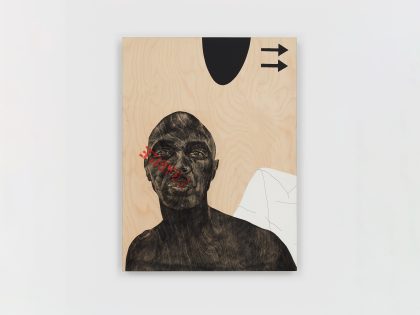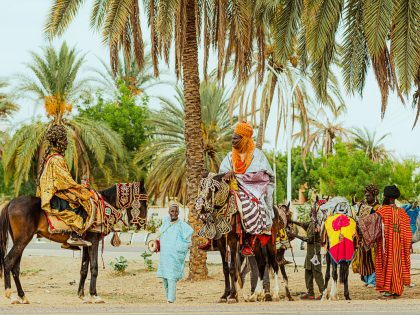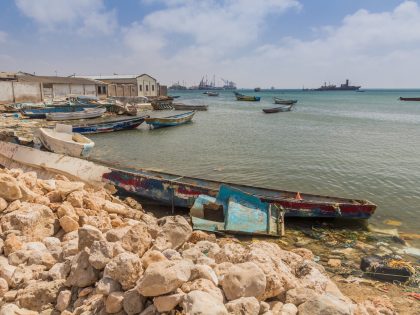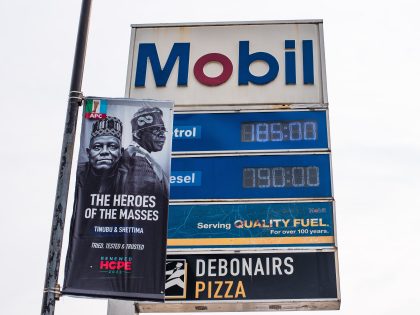Ghana Takes The Apollo

Sarkodie
We arrived at the Apollo Theater to see hiplife superstar Sarkodie at 7:00 p.m., an hour before the show was supposed to start. At 8:00 p.m., the Apollo was barely half-full, none of the opening acts had taken the stage, and we were feeling anxious.
Three hours later, and after several heavy Afrobeats hitters brought a sold-out Apollo Theater to life, Sarkodie took the stage to deafening applause and gave one of the most energetic performances I’ve ever seen. The crowd was electric, dancing in the aisles and on the seats, spilling drinks, chatting, and rapping along with the music until well after 2:00 AM. Anyone in the Apollo Theater that night would have agreed that hiplife has made its way across the Atlantic to successfully stamp its impression in the birthplace of hip hop. In all, the show lived up to its title: “History in the Making”.
In many ways, the Sarkodie Apollo show seems like a feather in the cap for the New York area Ghanian community. Ghanian immigrants started settling en masse in the Bronx in the 1980s, and like any recent immigrant community, it took time for them to find their voice amongst the diverse peoples of New York. Today, after many years of the development of that voice, NY based Ghanian youth have formed artist crews, promoted parties, created production companies such as Boogie Down Nima, iRapTV, and Level 7 Films, and have been able to make an impact on cultural scenes both locally and internationally. Hiplife has remained a central organizing feature of this cultural production.
The resounding success of the Apollo show then, is an interesting watershed moment in Black Atlantic cultural exchange. This is especially because for an outside observer, hiplife can easily be misconstrued and difficult to categorize. Critics often describe it as just a blend of hip hop and highlife, a Ghanaian genre incorporating aspects of traditional Akan music and Western instrumentation. Add to that, artists constantly code-switch, rapping in local dialects as well as Western languages. To the average consumer, hiplife might seem like a Ghanaian version of American rap, but in reality it is the product of trans-Atlantic musical and cultural evolution.
If we start to parse some of the shared aesthetics between hiplife and hip hop, we can start to see that there are so many threads of influence fanning out, that its hard to assert any claim to origins for any one of them. One prime example of this are the fashion aesthetics of Ghana’s hiplife generation. Standing amongst the crowd at the Apollo of mostly Ghanians, who painted the room in a myriad of bright hues, donning standout styles and lots and lots of bling, I felt quite underdressed. Many people would easily recognize the bling aesthetic that hiplife artists (and fans) engage in, as being part of hip hop fashion since the early days of the art form. But, if we look back to Ghanian history, we can see royals of the Ashanti Empire adorned with gold jewelry as an indication of status and wealth as well. It wouldn’t be unlikely to suggest that in the 1970s, when the USA was enjoying an awakening of African consciousness amongst Black Americans, such images had made their way into the communities where hip hop was born, providing a model for an aesthetic of Black empowerment. The same goes for Ghanian cultural imports such as Kente and Batik, which enjoyed a particularly strong revival during hip hop’s early 1990’s “Golden Era”. When fans come dressed in their best outfits adorned with fancy accessories, and dancers on stage come out in outfits patterned with splashes of Kente and Batik, it shows that through the re-appropriation of their own traditions, they are able to participate both in their own cultural heritage and a global Black aesthetic. Such examples show that hiplife, rather than being a regurgitated copy of hip hop, is a beautiful product of complexity and adaptation of Ghanian culture to an inherently interconnected world.
While the Apollo show was in actuality the celebration of the triumph of a community, the man of the hour was clearly Sarkodie. When he came out he wore only a sleeveless black tunic, black pants and sunglasses, standing in stark contrast to the many freshly dressed, jewelry-adorned patrons and performers. An audience that had been laughing, dancing and drinking for hours, now swooned with his every move, spellbound by his presence.
However, Sarkodie definitely did not forget the greater community that surrounded him that night. Performing “Pon Di Ting” with Banky W, “M3gye Wo Girl” with Shatta Wale and “Chingam” with Bisa Kdei, Sarkodie shared the stage for several collaborations with the other artists. He also thanked the artists and fans multiple times throughout the show, keeping with hiplife godfather Reggie Rockstone’s original vision of the movement as a medium to uplift Ghanian youth. At the Apollo show it was clear that today’s hiplife artists remain proud of where they came from and whom they represent. They place a high premium on remaining true to themselves, and all throughout Sarkodie’s performance, that message remained loud and clear. It was refreshing to see a young and successful performer be so humble and focused on others. He closed out the show with his smash hit “Adonai”, and by the time he bowed and walked off the stage, every soul in the building was chanting and begging for more.
With all said and done, Sarkodie, Lighter, Banky W, EL, Kwaw Kese, Bisa Kdei and the whole crew who performed that night proved that Afrobeats don’t need African soil to flourish. And Harlem’s Apollo Theater can now count a Ghanian contribution to its roster of “history making” performances.




































